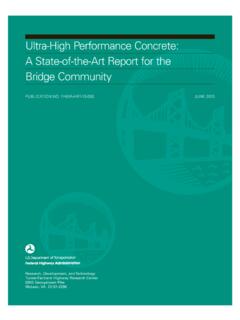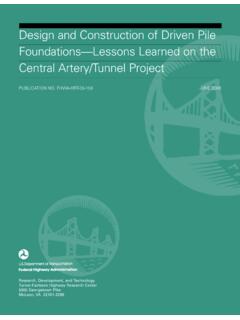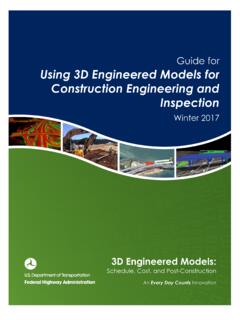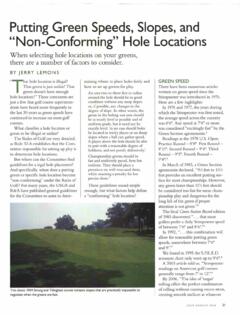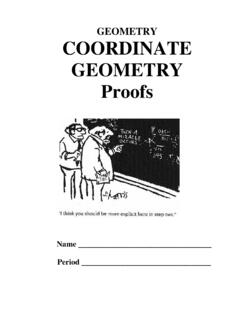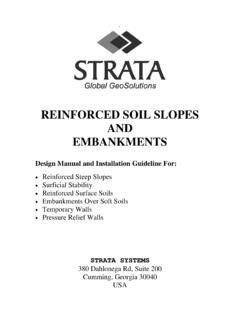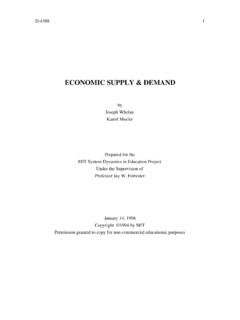Transcription of GEC 11 Design and Construction of Mechanically Stabilized ...
1 U. S. Department of Transportation Publication No. FHWA-NHI-10-024 Federal Highway Administration FHWA GEC 011 Volume I November 2009 NHI Courses No. 132042 and 132043 Design and Construction of Mechanically Stabilized Earth Walls and Reinforced Soil Slopes Volume I Developed following: AASHTO LRFD Bridge Design and AASHTO LRFD Bridge Construction Specifications, 4th Edition, 2007, Specifications, 2nd Edition, 2004, with with 2008 and 2009 Interims. 2006, 2007, 2008, and 2009 Interims. NOTICE The contents of this report reflect the views of the authors, who are responsible for the facts and accuracy of the data presented herein. The contents do not necessarily reflect policy of the Department of Transportation. This report does not constitute a standard, specification, or regulation. The United States Government does not endorse products or manufacturers. Trade or manufacturer's names appear herein only because they are considered essential to the object of this document.
2 Technical Report Documentation Page 1. REPORT NO. 2. GOVERNMENT 3. RECIPIENT'S CATALOG NO. ACCESSION NO. FHWA-NHI-10-024 FHWA GEC 011-Vol I 4. TITLE AND SUBTITLE 5. REPORT DATE November 2009 Design of Mechanically Stabilized Earth Walls and Reinforced Soil Slopes Volume I 6. PERFORMING ORGANIZATION CODE 7. AUTHOR(S) 8. PERFORMING ORGANIZATION REPORT NO. Ryan R. Berg, ; Barry R. Christopher, , and Naresh C. Samtani, , 9. PERFORMING ORGANIZATION NAME AND ADDRESS 10. WORK UNIT NO. Ryan R. Berg & Associates, Inc. 11. CONTRACT OR GRANT NO. 2190 Leyland Alcove DTFH61-06-D-00019/T-06-001 Woodbury, MN 55125 12. SPONSORING AGENCY NAME AND ADDRESS 13. TYPE OF REPORT & PERIOD COVERED National Highway Institute Federal Highway Administration 14. SPONSORING AGENCY CODE Department of Transportation Washington, 15. SUPPLEMENTARY NOTES FHWA Technical Consultants: Rich Barrows, , Silas Nichols, , and Daniel Alzamora, Technical Consultant: James G.
3 Collin, , 16. ABSTRACT This manual is the reference text used for the FHWA NHI courses No. 132042 and 132043 on Mechanically Stabilized Earth Walls and Reinforced Soil Slopes and reflects current practice for the Design , Construction and monitoring of these structures. This manual was prepared to enable the engineer to identify and evaluate potential applications of MSE walls and RSS as an alternative to other Construction methods and as a means to solve Construction problems. The scope is sufficiently broad to be of value for specifications specialists, Construction and contracting personnel responsible for Construction inspection, development of material specifications and contracting methods. With the aid of this text, the engineer should be able to properly select, Design , specify, monitor and contract for the Construction of MSE walls and RSS embankments. The MSE wall Design within this manual is based upon Load and Resistance Factor Design (LRFD) procedures.
4 This manual is a revision (to LRFD) and an update to the FHWA NHI-00-043 manual (which was based upon allowable stress Design (ASD) procedures). 17. KEY WORDS 18. DISTRIBUTION STATEMENT Design , Load and Resistance Factor Design No restrictions. (LRFD), analysis, performance criteria, Mechanically Stabilized Earth (MSE) Walls, Reinforced Soil Slopes (RSS), soil reinforcement, geosynthetics, specifications, contracting methods 19. SECURITY CLASSIF. 20. SECURITY CLASSIF. 21. NO. OF PAGES 22 Unclassified Unclassified 306 SI CONVERSION FACTORS APPROXIMATE CONVERSIONS FROM SI UNITS Symbol When You Know Multiply By To Find Symbol LENGTH mm m m km millimeters meters meters kilometers inches feet yards miles in ft yd mi AREA mm2 m2 m2 ha km2 square millimeters square meters square meters hectares square kilometers square inches square feet square yards acres square miles in2 ft2 yd2 ac mi2 VOLUME ml l m3 m3 millimeters liters cubic meters cubic meters fluid ounces gallons cubic feet cubic yards fl oz gal ft3 yd3 MASS g kg grams kilograms ounces pounds oz lb TEMPERATURE C Celsius C + 32 Fahrenheit F kN/m3 WEIGHT DENSITY kilonewton / cubic m poundforce / cubic foot pcf FORCE and PRESSURE or STRESS N kN kPa kPa newtons kilonewtons kilopascals kilopascals 225 poundforce poundforce poundforce / sq in.
5 Poundforce / sq ft lbf lbf psi psf PREFACE Engineers and specialty material suppliers have been designing reinforced soil structures for the past 35 years. Currently, many state DOTs are transitioning their Design of substructures from Allowable Stress Design (ASD) to Load and Resistance Factor Design (LRFD) procedures. This manual is based upon LRFD for MSE wall structures. It has been updated from the 2001 FHWA NHI-00-043 manual. In addition to revision of the wall Design to LRFD procedures, expanded discussion on wall detailing and general updates throughout the manual are provided. The primary purpose of this manual is to support educational programs conducted by FHWA for transportation agencies. A second purpose of equal importance is to serve as the FHWA standard reference for highway projects involving MSE wall and reinforced soil structures. This Mechanically Stabilized Earth Walls (MSE) and Reinforced Soil Slopes (RSS), Design and Construction Guidelines Manual which is an update of the current FHWA NHI-00-043, has evolved from the following AASHTO and FHWA references: C AASHTO LRFD Bridge Design Specifications, 4th Edition, 2007, with 2008 and 2009 Interim Revisions.
6 C Earth Retaining Structures, by Tanyu, Sabatini, and Berg, FHWA-NHI-07-071 (2008). C AASHTO LRFD Bridge Construction Specifications, 2nd Edition, 2004, with 2006 Interim Revisions. C Geosynthetic Design and Construction Guidelines, by Holtz, Christopher, and Berg, FHWA HI-07-092 (2008). C Guidelines for Design , Specification, and Contracting of Geosynthetic Mechanically Stabilized Earth Slopes on Firm Foundations, by Berg, FHWA-SA-93-025, January 1993. C Reinforced Soil Structures - Volume I, Design and Construction Guidelines - Volume II, Summary of Research and Systems Information, by Christopher, Gill, Giroud, Mitchell, F. Schlosser, and J. Dunnicliff, FHWA RD 89-043 (1990). C Design and Construction Monitoring of Mechanically Stabilized Earth Structures, by DiMaggio, FHWA, (1994). C AASHTO Bridge T-15 Technical Committee unpublished working drafts for the update of Section of the AASHTO LRFD Bridge Design Specifications.
7 FHWA NHI-10-024 MSE Walls and RSS Vol I iii November 2009 The authors recognize the efforts and contributions of Messrs. Richard Barrows, , Silas Nichols, , and Daniel Alzamora who were the FHWA Technical Consultants for this work. The authors also recognize the contributions of the other Technical Consultants on this project. They are: C Tony Allen, of Washington DOT C Christopher Benda, of Vermont DOT C James Brennan, of Kansas DOT C James Collin, , of The Collin Group C Jerry DiMaggio, of the National Academy of Sciences C Kenneth L. Fishman, , of Earth Reinforcement Testing, Inc. C Kathryn Griswell, of CALTRANS C John Guido, of Ohio DOT C Dan Johnston, of South Dakota DOT C Dov Leshchinsky, of the University of Delaware C Michael Simac, of Earth Improvement Technologies, Inc. C James L. Withiam, , of D Appolonia Engineers And the authors acknowledge the contributions of the following industry associations: C Association of Metallically Stabilized Earth (AMSE) C Geosynthetic Materials Association (GMA) C National Concrete Masonry Association (NCMA) A special acknowledgement of Mr.
8 Jerry A. DiMaggio, who was the FHWA Technical Consultant for most of the above referenced publications. Mr. DiMaggio's guidance and input to this and the previous works has been invaluable. Lastly, the authors wish to acknowledge the extensive work of the late Victor Elias, for his vital contributions and significant effort as Lead Author in preparing the earlier two (1997, 2001) versions of this manual, and as the author of the earlier companion manuals on corrosion/degradation of soil reinforcements. Mr. Elias was instrumental in the introduction and implementation of reinforced soil technology in the , as a Vice President for The Reinforced Earth Company from 1974 to 1985. He was instrumental in research, refinement of Design methods, and standards of practice and codes for MSE walls, as a Consultant from 1985 until 2006. FHWA NHI-10-024 MSE Walls and RSS Vol I iv November 2009 TABLE OF CONTENTS Volume I CHAPTER 1 INTRODUCTION .. 1-1 OBJECTIVES.
9 1-1 Scope .. 1-1 Source Documents .. 1-2 1-3 HISTORICAL DEVELOPMENT .. 1-4 LOAD AND RESISTANCE FACTOR Design (LRFD) .. 1-12 CHAPTER 2 SYSTEMS AND PROJECT EVALUATION .. 2-1 APPLICATIONS .. 2-1 MSE Walls .. 2-1 Reinforced Soil 2-4 ADVANTAGES AND POTENTIAL 2-6 Advantages of Mechanically Stabilized Earth (MSE) 2-6 Advantages of Reinforced Soil Slopes (RSS).. 2-6 Potential Disadvantages .. 2-7 RELATIVE 2-7 DESCRIPTION OF MSE/RSS SYSTEMS .. 2-10 Systems Differentiation .. 2-10 Types of Systems .. 2-11 Facing Systems .. 2-12 Reinforcement Types .. 2-16 Reinforced Fill Materials .. 2-17 Appurtenant Materials of Construction .. 2-18 Construction SEQUENCE.
10 2-18 Construction of MSEW systems with precast facings .. 2-18 Construction of MSE systems with Flexible Facings .. 2-24 RSS 2-28 SITE EVALUATION .. 2-28 Site Exploration .. 2-28 Field Reconnaissance .. 2-30 Subsurface Exploration .. 2-30 Laboratory Testing .. 2-32 Foundation Soils .. 2-33 PROJECT 2-34 Structure Selection Factors .. 2-34 Geologic and Topographic Conditions .. 2-35 Environmental Conditions .. 2-36 Size and Nature of Structure .. 2-37 Aesthetics .. 2-38 Questionable Applications .. 2-38 ESTABLISHMENT OF PROJECT CRITERIA .. 2-38 Alternates .. 2-39 Facing 2-39 FHWA NHI-10-024 Table of Contents MSE Walls and RSS Vol I v November 2009 Performance Criteria.


